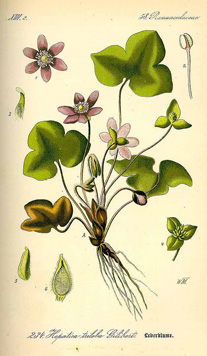Heroic Hepatica
By Audrey Stallsmith

Why liftest thou, so premature, thy head
Amid the withered waste, pale flower? Say why
Dost thou, alone and desolate, defy
The year, yet unconfirmed, while there is shed
No wholesome dew upon thy leaf-strewn bed,
All choked and matted; but the frost-wind’s sigh
Is heard at eve, thy chill slope rustling by?
"To the Hepatica Triloba Found in March" by William Croswell
I bought some liverwort (Hepatica acutiloba) seeds last autumn before I discovered how complicated their germination could be! Apparently the root emerges first—at temperatures of around 40 degrees Fahrenheit--and remains nothing but a root for several months. During that time, the seeds must be kept cool.
Although I do chill some seeds in damp paper towels in the refrigerator, I usually take them out when they begin to break open, so the liverwort ones have me stymied. I probably should have planted them outdoors as soon as I received them. Since I didn’t get around to that at the time, they still remain in the packet of damp vermiculite in which they were mailed to me.
A low-growing plant sometimes called Anemone hepatica instead, liverwort is one of the earliest wildflowers to bloom, with the "noble" Hepatica nobilis being native to Europe, the U.S., and Japan--the round-lobed americana and sharp-lobed acutiloba to the U. S. only. The flowers can appear in late winter in warmer climates, usually in early spring in colder ones. Their genus name derives from the Greek hepar (“liver”), since the plants' three-lobed leaves--which frequently age to burgundy--are thought to resemble that organ.
Although liverwort is a member of the buttercup family, the hues of its 1/2 to 1-inch blooms tend toward the cooler end of the color spectrum, including purple, blue, pink, and white. Its “petals” actually are sepals, usually six per bloom.
Due to the doctrine of signatures—which held that plants could heal whatever organ they most resembled, Hepatica was once gathered in huge quantities for use in patent medicines.
Despite its associations with the liver, it also was used to treat lung problems such as consumption. Since it fell out of favor before being endangered by its overharvesting, we probably can conclude that it didn’t work!
It will work to cheer your spirits in the spring, though. The flower stands for “confidence” in the Language of Flowers, perhaps because it takes a lot of confidence to bloom before anybody else does!
I just read in an old garden book that it is best to sow liverwort outdoors in August, but that ship already had sailed before I received the seeds! So, although I'll probably try cooling those seeds in the refrigerator, I’ve concluded that it probably would be simpler to buy liverwort plants than to start them myself. The wild species generally are available at not too steep a price, but the “fancy” double cultivars developed by Japanese breeders often run between $30 and $130 each!
Speaking of ships. . . Until mine comes in, I will have to stick to the wildflower types and gaze longingly upon the others from afar. According to the doctrine of Murphy, anything that expensive probably would die on me anyhow!
Hepatica triloba image is by O. W. Thome from Flora von Deutschland Osterreich und der Schweiz, Vol. 2, courtesy of plantillustrations.org..








